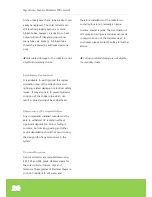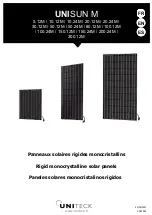
39
standard frame side rails using the supplied
M8x20 bolts and nut lock assemblies, the
other end to the roof rafter using two
stainless steel coach screws. Once the upper
straps are attached and tightened, adjust the
bottom straps to ensure that they too are
providing support to the frame.
Fragile Slates / High Wind Area
In areas of high wind or where the roof
slates are fragile then the roof attachment
straps should NOT be used.
A rigid solar stand-off bracket (similar to
those shown below) and flashing is
recommended. Care should be taken when
cutting tiles/slates to avoid breakage, as new
tiles/slates may not be readily available. It is
recommended that in such cases a
professional roofer is used.
Manifold and Bottom Track
Attachment
Once the standard frame channels are
secured in place on the roof, the manifold
and bottom track may be attached, taking
care to ensure they are correctly aligned. The
manifold and bottom track will lock into the
frame, secured from above and below with
the attachment plates that are already in
place. Make sure that the Manifold and
Bottom Support Rail are square with the
frame side rails.
To ensure proper tube engagement, each
tube in the Manifold should line up with the
corresponding ‘cradle’ on the Bottom
Support Rail. Each Tube is installed with the
Heat Pipe snugly engaged within the Header
with the opening of the glass tube inside the
Manifold header. The bottom of the tube,
protected by the Rubber Cap, locates in the
‘cradle’ between each set of prongs on the
Bottom Support Rail, where it is held in
place by the Bottom Support Rail Clip.
Mounting on Low
Pitched Roof
If the roof pitch is insufficient, an adjustable
angle roof frame kit (as shown below) can
be used to increase the angle by 27°to 57°.
Adjustable frame kits combine with the
standard frame components to form a
complete frame assembly.
It is recommended that the adjustable frame
kits are completely assembled on the ground
before taking onto the roof – see next
section.
















































